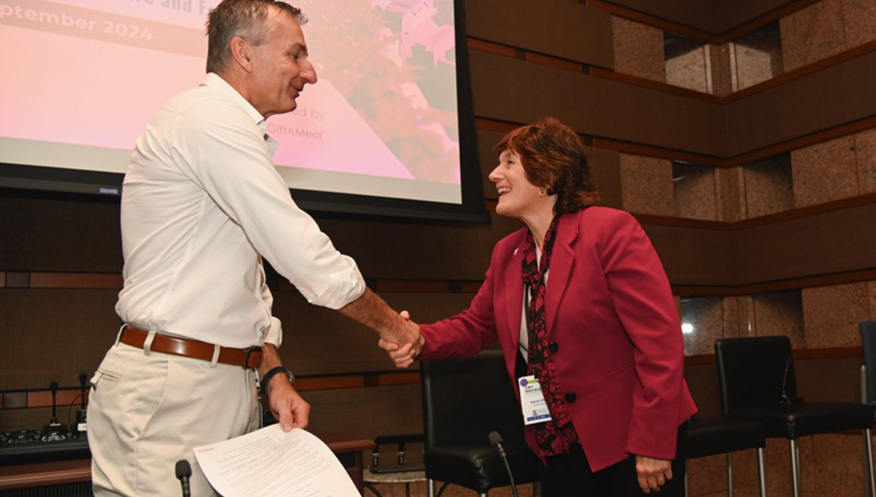Purdue, Bayer announce partnership to address regenerative agriculture on global scale


New consortium to focus on data-driven, holistic approach to create sustainable and resilient farming practices

Karen Plaut, Purdue executive vice president for research [right], shakes hands with Robert Reiter, Bayer head of crop science research and development, after signing an agreement Sept. 19, 2024, in St. Louis creating the Coalition for Sustainable and Regenerative Agriculture. (Photo courtesy of Bayer)
Introduction
On Thursday (Sept. 19), Purdue University and Bayer announced the creation of the Coalition for Sustainable and Regenerative Agriculture, a public-private partnership designed to help improve the soil health of farmland while also increasing food production for a growing population.
Mission and Objectives
The coalition’s mission is to generate robust, real-world data in support of regenerative agriculture practices to help farmers restore soil health and biomass, increase biodiversity, and improve the resiliency of ecosystems over time. The coalition’s new framework will also support education and outreach programs to enhance sustainable and regenerative agriculture.
Additional Information
The coalition will be administered through Bayer at Convergence, the company’s innovation center at Discovery Park District at Purdue.
Partnership and Goals
The coalition’s goal is to accelerate the adoption of agricultural systems that restore soil, water and wildlife while making farms healthier and more resilient. The partners say there is a growing need for innovative solutions at scale to address environmental concerns and to create positive, measurable impact to incentivize producers.
Key Areas of Focus
- Climate-smart agriculture: Integrate technology to adapt to changing weather patterns, improve water management and optimize resource use.
- Regenerative practices: Develop more robust practices that capture and store carbon in the soil. Promote techniques that improve soil health and biodiversity and enhance long-term productivity.
- Farmer empowerment: Provide farmers with the tools, knowledge and resources they need to adopt sustainable practices and access premium markets for their products.
- Profitability and policy advocacy: Provide additional scientific research that supports or incentivizes sustainable practices for farmers and landowners.
Implementation and Collaboration
The coalition will leverage previous investments in digital phenotyping capabilities at Purdue Agronomy Center for Research and Education (ACRE) and at the Purdue Agricultural Centers (PACs) and will utilize dynamic and relevant Extension programs, strength in collaborative research across colleges, and support for related projects that are underway. It will build on these existing strengths to create test beds for sustainable and regenerative agriculture technologies that provide demonstrations for a wide variety of agricultural production systems and technologies — regardless of farm scale or end product.
Expansion and Future Partnerships
This public-private partnership is expected to evolve and expand to other partners from the agricultural sector, allowing for an even larger network of field sites to test and collect data on this more holistic approach to farming.
About Purdue University
Purdue University is a public research institution demonstrating excellence at scale. Ranked among top 10 public universities and with two colleges in the top four in the United States, Purdue discovers and disseminates knowledge with a quality and at a scale second to none. More than 105,000 students study at Purdue across modalities and locations, including nearly 50,000 in person on the West Lafayette campus. Committed to affordability and accessibility, Purdue’s main campus has frozen tuition 13 years in a row. See how Purdue never stops in the persistent pursuit of the next giant leap — including its first comprehensive urban campus in Indianapolis, the Mitch Daniels School of Business, Purdue Computes and the One Health initiative — at https://www.purdue.edu/president/strategic-initiatives.
About Bayer
Bayer is a global enterprise with core competencies in the life science fields of health care and nutrition. In line with its mission, “Health for All, Hunger for None,” the company’s products and services are designed to help people and the planet thrive by supporting efforts to master the major challenges presented by a growing and aging global population. Bayer is committed to driving sustainable development and generating a positive impact with its businesses. At the same time, the Group aims to increase its earning power and create value through innovation and growth. The Bayer brand stands for trust, reliability and quality throughout the world. In fiscal 2023, the Group employed around 100,000 people and had sales of 47.6 billion euros. R&D expenses before special items amounted to 5.8 billion euros. For more information, go to www.bayer.com.
SDGs, Targets, and Indicators
1. SDGs Addressed or Connected to the Issues Highlighted in the Article:
- SDG 2: Zero Hunger
- SDG 12: Responsible Consumption and Production
- SDG 13: Climate Action
- SDG 15: Life on Land
- SDG 17: Partnerships for the Goals
2. Specific Targets Based on the Article’s Content:
- Target 2.4: By 2030, ensure sustainable food production systems and implement resilient agricultural practices that increase productivity and production, that help maintain ecosystems, that strengthen capacity for adaptation to climate change, extreme weather, drought, flooding, and other disasters, and that progressively improve land and soil quality.
- Target 12.4: By 2020, achieve the environmentally sound management of chemicals and all wastes throughout their life cycle, in accordance with agreed international frameworks, and significantly reduce their release to air, water, and soil in order to minimize their adverse impacts on human health and the environment.
- Target 13.3: Improve education, awareness-raising, and human and institutional capacity on climate change mitigation, adaptation, impact reduction, and early warning.
- Target 15.1: By 2020, ensure the conservation, restoration, and sustainable use of terrestrial and inland freshwater ecosystems and their services, in particular forests, wetlands, mountains, and drylands, in line with obligations under international agreements.
- Target 17.16: Enhance the global partnership for sustainable development, complemented by multi-stakeholder partnerships that mobilize and share knowledge, expertise, technology, and financial resources, to support the achievement of the sustainable development goals in all countries, in particular developing countries.
3. Indicators Mentioned or Implied in the Article:
- Indicator 2.4.1: Proportion of agricultural area under productive and sustainable agriculture
- Indicator 12.4.1: Number of parties to international multilateral environmental agreements on hazardous waste, including their disposal
- Indicator 13.3.1: Number of countries that have integrated mitigation, adaptation, impact reduction, and early warning into primary, secondary, and tertiary curricula
- Indicator 15.1.1: Forest area as a proportion of total land area
- Indicator 17.16.1: Number of countries reporting progress in multi-stakeholder development effectiveness monitoring frameworks that support the achievement of the sustainable development goals
Table: SDGs, Targets, and Indicators
| SDGs | Targets | Indicators |
|---|---|---|
| SDG 2: Zero Hunger | Target 2.4: By 2030, ensure sustainable food production systems and implement resilient agricultural practices that increase productivity and production, that help maintain ecosystems, that strengthen capacity for adaptation to climate change, extreme weather, drought, flooding, and other disasters, and that progressively improve land and soil quality. | Indicator 2.4.1: Proportion of agricultural area under productive and sustainable agriculture |
| SDG 12: Responsible Consumption and Production | Target 12.4: By 2020, achieve the environmentally sound management of chemicals and all wastes throughout their life cycle, in accordance with agreed international frameworks, and significantly reduce their release to air, water, and soil in order to minimize their adverse impacts on human health and the environment. | Indicator 12.4.1: Number of parties to international multilateral environmental agreements on hazardous waste, including their disposal |
| SDG 13: Climate Action | Target 13.3: Improve education, awareness-raising, and human and institutional capacity on climate change mitigation, adaptation, impact reduction, and early warning. | Indicator 13.3.1: Number of countries that have integrated mitigation, adaptation, impact reduction, and early warning into primary, secondary, and tertiary curricula |
| SDG 15: Life on Land | Target 15.1: By 2020, ensure the conservation, restoration, and sustainable use of terrestrial and inland freshwater ecosystems and their services, in particular forests, wetlands, mountains, and drylands, in line with obligations under international agreements. | Indicator 15.1.1: Forest area as a proportion of total land area |
| SDG 17: Partnerships for the Goals | Target 17.16: Enhance the global partnership for sustainable development, complemented by multi-stakeholder partnerships that mobilize and share knowledge, expertise, technology, and financial resources, to support the achievement of the sustainable development goals in all countries, in particular developing countries. | Indicator 17.16.1: Number of countries reporting progress in multi-stakeholder development effectiveness monitoring frameworks that support the achievement of the sustainable development goals |
Source: purdue.edu








